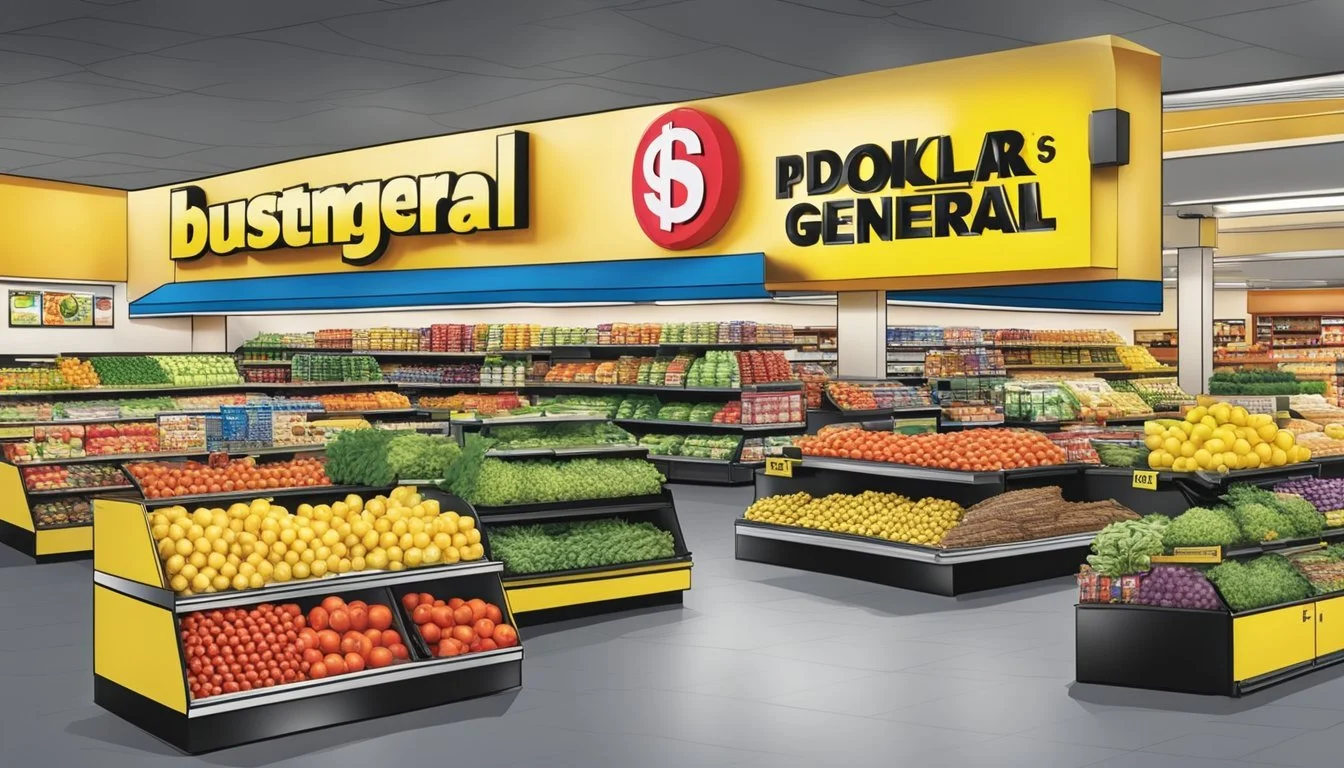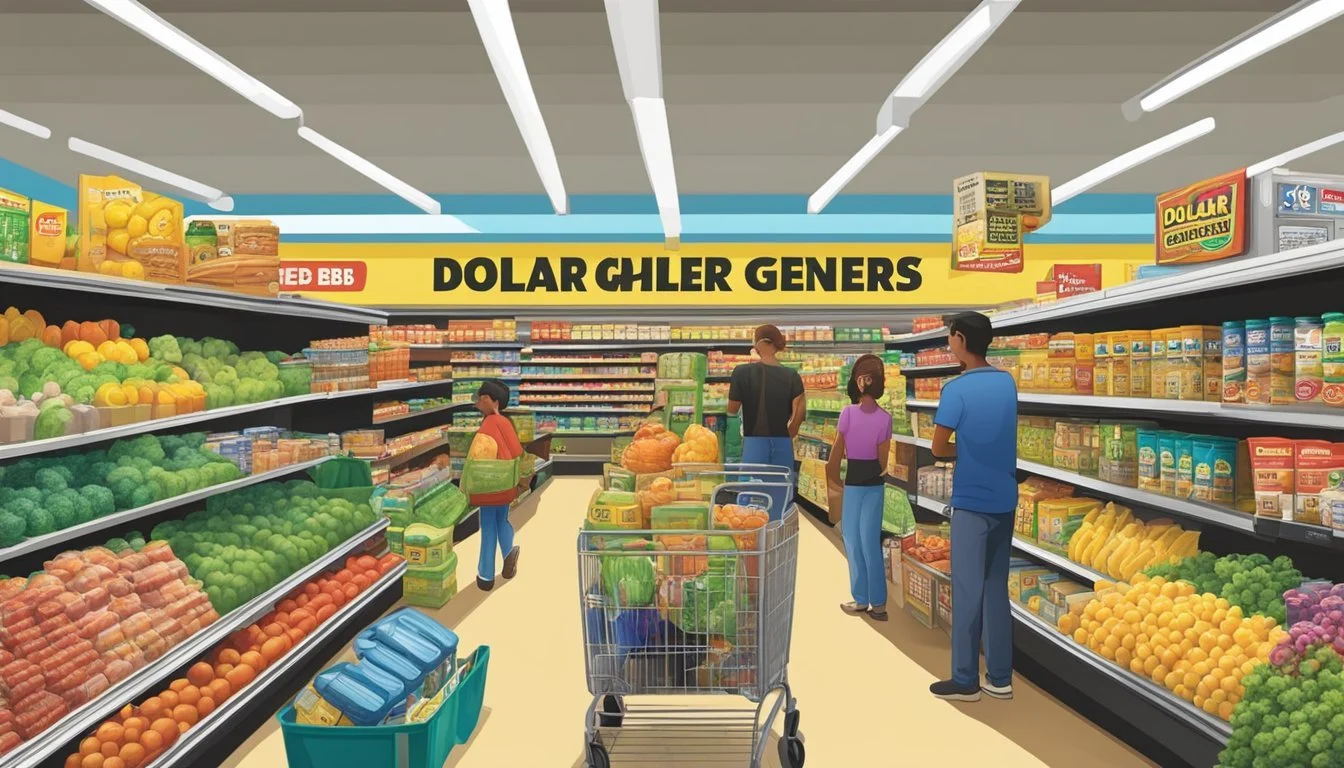Dollar General vs H-E-B
Comparing Prices, Selection, and Quality
Dollar General and H-E-B are two prominent grocery retailers with distinct approaches to serving customers. While Dollar General focuses on offering affordable products nationwide, H-E-B has built a strong regional presence in Texas with a reputation for quality and variety.
H-E-B generally provides a better overall shopping experience compared to Dollar General, with higher-quality products, fresher produce, and a wider selection of items. H-E-B stores are known for their cleanliness, friendly staff, and commitment to supporting local communities. The Texas-based chain offers an extensive range of private-label products that often rival or surpass national brands in quality.
Dollar General, on the other hand, excels in convenience and affordability. With its smaller store formats and focus on essential items, Dollar General provides quick and easy access to basic groceries and household goods at competitive prices. This makes it a practical option for shoppers on a tight budget or those living in areas with limited grocery options.
Company Overviews
Dollar General and H-E-B are two prominent players in the American grocery retail landscape. These companies have unique histories and approaches to serving customers, shaping their current market positions and store formats.
History of Dollar General
Dollar General began in 1939 when J.L. Turner and his son Cal opened J.L. Turner and Son Wholesale in Scottsville, Kentucky. The company initially focused on closeouts and excess inventory from manufacturers. In 1955, they adopted the Dollar General name and converted their wholesale business to retail.
Dollar General pioneered the dollar store concept, offering products at $1 or less. Over time, the company expanded its price points while maintaining a focus on value. The retailer grew rapidly, going public in 1968 and expanding across the United States.
Today, Dollar General operates over 17,000 stores in 46 states. The company specializes in smaller-format stores, often located in rural and suburban areas underserved by larger retailers.
History of H-E-B
H-E-B's roots trace back to 1905 when Florence Butt opened the C.C. Butt Grocery Store in Kerrville, Texas. Her son Howard E. Butt took over the business in the 1920s, expanding it into a regional chain.
The company adopted the name H-E-B in 1928, using Howard E. Butt's initials. H-E-B focused on serving Texas communities, gradually expanding its presence throughout the state. The retailer introduced innovative concepts like in-store bakeries and pharmacies.
H-E-B remains privately held and family-operated. The company operates over 340 stores in Texas and Mexico. H-E-B has developed various store formats, including:
Traditional H-E-B supermarkets
H-E-B Plus! (larger format with expanded non-food items)
Central Market (gourmet and specialty foods)
The retailer is known for its strong community involvement and emphasis on local products.
Product Offerings
Dollar General and H-E-B offer distinct product selections to cater to different customer needs. Their offerings vary in terms of brand diversity, private labels, produce quality, and specialty items.
Brand and Product Diversity
Dollar General focuses on providing essential items at affordable prices. The store stocks around 10,000 SKUs, primarily consisting of packaged goods, household items, and basic groceries. H-E-B, in contrast, offers a more extensive selection with approximately 100,000 SKUs. This includes a wide range of national brands, regional favorites, and gourmet options.
H-E-B's larger stores allow for greater product variety, including fresh meats, seafood, and an expansive produce section. Dollar General's limited space restricts its fresh food offerings, with a smaller selection of fruits, vegetables, and dairy products.
Exclusive Brands and Private Labels
Both retailers have developed their own private label brands. Dollar General's primary private label is Clover Valley, which spans various product categories. The chain also offers DG Home and DG Health for household and personal care items respectively.
H-E-B has invested heavily in its private label program. The H-E-B brand covers a wide range of products, from groceries to household goods. Hill Country Fare serves as their value brand, while Central Market offers premium alternatives.
H-E-B's Meal Simple line provides convenient, ready-to-eat options. These private labels allow H-E-B to offer competitive prices while maintaining quality control.
Freshness and Quality of Produce
H-E-B is known for its commitment to fresh, high-quality produce. The chain sources fruits and vegetables from local farmers when possible, ensuring freshness and supporting regional agriculture. Their produce departments are typically larger and more diverse than Dollar General's.
Dollar General's produce offerings are more limited. The chain has been expanding its fresh food sections in recent years, but the selection remains smaller than traditional grocery stores. Quality can vary between locations due to less frequent deliveries and smaller storage capacities.
H-E-B's focus on freshness extends to its meat and seafood departments, which offer a wide variety of cuts and options. Dollar General typically stocks only basic meat products, often frozen or pre-packaged.
Organic and Specialty Products
H-E-B has embraced the growing demand for organic and specialty products. The chain offers a substantial selection of organic produce, meats, and packaged goods. H-E-B also caters to dietary restrictions with gluten-free, vegan, and international food options.
Dollar General's organic and specialty offerings are limited. The chain has introduced some organic items and healthier snack options in recent years, but the selection remains narrow compared to H-E-B.
H-E-B's specialty departments, such as bakery and deli, provide freshly prepared items and gourmet options. Dollar General typically lacks these specialized departments, focusing instead on shelf-stable and packaged goods.
Pricing Strategies
Dollar General and H-E-B employ distinct pricing approaches to attract and retain customers. These strategies aim to provide value while maintaining profitability in the competitive grocery market.
Everyday Low Prices and Discounts
Dollar General focuses on offering consistently low prices across its product range. The company leverages its smaller store format and limited selection to keep operational costs down, passing savings to customers. H-E-B, on the other hand, balances everyday low prices with periodic discounts on select items.
H-E-B's larger stores allow for a wider variety of products, including premium and organic options. This diversity enables them to maintain competitive prices on staple items while offering higher-margin specialty products.
Both retailers adjust their pricing in response to local market conditions and inflation trends. As food prices fluctuate, these stores work to absorb some costs to maintain customer loyalty.
Coupons and Weekly Circulars
Coupons and weekly circulars play a crucial role in both stores' pricing strategies. Dollar General distributes digital and paper coupons, often focusing on household essentials and packaged goods. Their app features exclusive deals and personalized offers based on shopping history.
H-E-B's circular highlights a mix of fresh produce, meat, and pantry staples. The company's digital coupon program integrates with its loyalty card, allowing customers to clip and redeem offers easily. H-E-B also runs combo loco deals, offering discounts when customers purchase multiple related items.
Both retailers use these promotional tools to drive foot traffic and encourage larger basket sizes. The frequency and depth of discounts often align with seasonal events and competitor activities.
Price Comparison with Competitors
Dollar General and H-E-B regularly conduct price comparisons to ensure competitiveness. Dollar General often benchmarks against Walmart, adjusting prices on key items to maintain its value perception. The company's smaller format allows for quick price changes in response to local competition.
H-E-B takes a more comprehensive approach, monitoring prices across various competitors including traditional grocers, discount stores, and online retailers. They use this data to fine-tune pricing on a store-by-store basis, reflecting regional preferences and competitive landscapes.
Both retailers emphasize value beyond just the lowest price. They consider factors such as product quality, store experience, and customer service in their overall value proposition. This holistic approach helps them differentiate from purely price-driven competitors.
Shopping Experience
Dollar General and H-E-B offer distinct shopping experiences tailored to different consumer needs. Their approaches to store ambiance, customer service, checkout efficiency, and convenience shape how customers perceive and interact with each retailer.
In-Store Ambiance and Layout
Dollar General stores typically feature a no-frills layout with simple shelving and basic decor. The aisles are narrow and packed with a variety of products, creating a treasure hunt atmosphere. Lighting tends to be functional rather than atmospheric.
H-E-B, in contrast, invests heavily in store design and ambiance. Their stores boast wider aisles, creative displays, and often include specialty departments like bakeries and delis. The lighting is warmer and more inviting, contributing to a more upscale feel.
Dollar General's compact size allows for quick shopping trips, while H-E-B's larger footprint accommodates a more extensive product selection and encourages browsing.
Customer Service and Trust
H-E-B has built a strong reputation for customer service and community engagement. Their staff often receive extensive training, resulting in knowledgeable and helpful interactions. The company's commitment to local sourcing and community initiatives has fostered a high level of customer trust.
Dollar General's approach to customer service is more streamlined. With fewer staff members per store, the focus is on efficiency rather than personalized attention. However, the company's expansion into fresh food offerings and basic health services demonstrates efforts to build customer trust and meet community needs.
Checkout Efficiency
Dollar General emphasizes quick transactions with minimal wait times. Their stores typically have fewer checkout lanes but aim for rapid processing. Self-checkout options are increasingly available in some locations.
H-E-B offers a mix of traditional checkout lanes and self-service options. During peak hours, they often open additional lanes to manage customer flow. Some H-E-B stores feature advanced technology like scan-and-go systems to enhance checkout efficiency.
Both retailers have introduced curbside pickup services, with Dollar General notably allowing coupon use for these orders.
Convenience and Store Proximity
Dollar General's business model focuses on accessibility, with stores strategically placed in rural and urban areas often underserved by larger retailers. This approach makes Dollar General a convenient option for quick purchases and essential items.
H-E-B maintains a strong presence in Texas but has fewer total locations. Their stores are generally larger and located in more populated areas. While this may mean longer travel times for some customers, H-E-B compensates by offering a more comprehensive shopping experience.
Dollar General's smaller format allows for faster shopping trips, while H-E-B's larger stores provide a one-stop-shop for a wider range of needs.
Additional Services
Dollar General and H-E-B offer convenient services to enhance the shopping experience. Both stores have implemented modern solutions to cater to different customer needs and preferences.
Curbside Pickup and Delivery
Dollar General provides curbside pickup at select locations. Customers can place orders online and collect their groceries without entering the store. H-E-B offers a more extensive curbside service, available at most locations. Their user-friendly app allows easy ordering and scheduling of pickup times.
H-E-B excels in delivery options, partnering with Instacart to bring groceries directly to customers' homes. Dollar General has limited delivery services, primarily focusing on in-store shopping and curbside pickup.
Membership and Loyalty Programs
H-E-B runs a popular loyalty program called H-E-B Points. Members earn points on purchases, which can be redeemed for discounts or free products. The program also offers personalized coupons and exclusive deals.
Dollar General's DG Digital Coupons program allows customers to clip digital coupons for additional savings. While not a traditional loyalty program, it provides regular discounts to frequent shoppers.
Both stores offer mobile apps for easy access to deals and digital coupons. H-E-B's app includes additional features like shopping lists and recipe suggestions.
Market Presence and Expansion
Dollar General and H-E-B have distinct strategies for market presence and growth. Their approaches differ in regional focus and national reach, shaping their competitive positions in the grocery industry.
Regional Dominance
H-E-B reigns supreme in South Texas, with a particularly strong presence in Austin. The company opened 10 new stores in the past year alone, reinforcing its regional stronghold. H-E-B's deep Texas roots have cultivated a cult following among local shoppers.
The chain's commitment to the Texas market is evident in its tailored product offerings and community involvement. This localized approach has helped H-E-B maintain customer loyalty and fend off competition in its core territory.
National Footprint and Growth
Dollar General boasts a much larger national presence compared to H-E-B. The company recently celebrated the opening of its 20,000th store in southeastern Texas, marking a significant milestone in its expansion efforts.
Dollar General's growth strategy targets rural and urban areas across the United States. The retailer has capitalized on economic recessions and changing consumer behaviors to rapidly increase its store count.
While H-E-B focuses on deepening its Texas presence, Dollar General continues to expand its footprint across multiple states. This broader reach allows Dollar General to tap into diverse markets and potentially achieve higher overall revenue.
Consumer Perception and Brand Reputation
Dollar General and H-E-B have distinct reputations among consumers. Their perceived quality, value offerings, and industry recognition shape how shoppers view these grocery chains.
Perceived Quality and Value
Dollar General focuses on affordability, offering low prices on everyday items. Many consumers see it as a budget-friendly option for basic necessities. The chain's widespread presence in rural areas makes it a convenient choice for many shoppers.
H-E-B, on the other hand, has built a reputation for quality products and excellent customer service. Texans often express strong loyalty to the brand. H-E-B's private label items are particularly popular, making up nearly 27% of the company's revenues in 2022.
Awards and Recognitions
H-E-B consistently ranks highly in consumer surveys. In 2023, dunnhumby's Retailer Preference Index named H-E-B the top customer-preferred grocery store in the U.S. The chain outranked major competitors like Amazon and Costco.
Dollar General has received recognition for its business model and growth. Forbes has included the company on its lists of America's largest public companies. While Dollar General may not win as many customer satisfaction awards, its rapid expansion demonstrates its appeal to budget-conscious shoppers.
Impact of Global Events on Pricing and Availability
Global events have significantly affected grocery pricing and availability at both Dollar General and H-E-B. The COVID-19 pandemic disrupted supply chains worldwide, leading to shortages and price increases across the food industry.
Inflation has played a major role in driving up food prices since 2020. Both Dollar General and H-E-B have had to adjust their pricing strategies in response to rising costs from suppliers.
Dollar General expanded its footprint during this period, capitalizing on increased demand for low-cost groceries. However, this rapid growth has faced criticism from some local officials concerned about economic impacts.
H-E-B has focused on maintaining product availability despite supply chain challenges. The company's president, Craig Boyan, noted ongoing difficulties in navigating consumer wariness and persistently rising prices.
April typically marks the start of easing winter-related supply issues. However, lingering pandemic effects have disrupted normal seasonal patterns for both retailers.
High prices have become a contentious issue. The FTC reported that some large grocery chains raised prices more than necessary to cover increased costs during the pandemic, though specific companies were not named.
Both Dollar General and H-E-B continue to adapt their operations in response to these global pressures. They face the challenge of balancing competitive pricing with maintaining profitability in an uncertain economic environment.
Conclusion
Dollar General and H-E-B cater to different consumer needs in the grocery market. Dollar General focuses on providing affordable options in a convenient, small-format setting.
H-E-B offers a wider selection of products, including high-quality fresh produce and private-label items. The Texas-based chain is known for its superior customer service and community engagement.
Price-conscious shoppers may find Dollar General's deals appealing for everyday essentials. However, H-E-B's larger stores provide more variety and fresh options for those seeking a full-service grocery experience.
Product quality tends to be higher at H-E-B, with the chain receiving praise for items like ripe avocados. Dollar General's strengths lie in its widespread accessibility and budget-friendly merchandise.
Ultimately, the choice between these two stores depends on individual priorities. Shoppers valuing affordability and quick trips may prefer Dollar General. Those seeking a diverse selection and premium products are likely to favor H-E-B.
Both retailers have carved out distinct niches in the competitive grocery landscape. Their differing approaches demonstrate the varied preferences of American consumers when it comes to food shopping.









